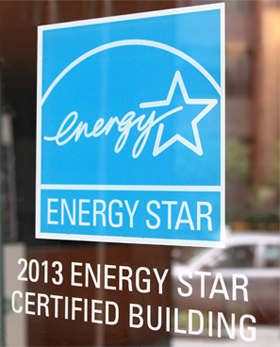 Most of us have seen the blue ENERGY STAR label–perhaps on a water heater, a refrigerator, or an air conditioner. And according to a recent study, most of us understand that the ENERGY STAR label conveys a message of energy stewardship and efficiency.
Most of us have seen the blue ENERGY STAR label–perhaps on a water heater, a refrigerator, or an air conditioner. And according to a recent study, most of us understand that the ENERGY STAR label conveys a message of energy stewardship and efficiency.
At EnergyCAP, we also understand its importance to our customers and audiences, most of whom are aware that an ENERGY STAR ranking and/or certification is available for whole buildings (not just for appliances).
But despite that knowledge, many building owners across the country are not tracking their energy use with this free online tool.
Here are five incentives for ENERGY STAR tracking:
#1: ENERGY STAR may already be mandated in your city.
Or even your state. Mandated ENERGY STAR tracking is especially making inroads in the public sector, since ENERGY STAR building rankings provide a measure of accountability for energy use.
The trend is growing every year as more and more cities and states look for ways to reduce costs. So if you’re not tracking yet, you may want to get started and stay ahead of the curve. Here is a relatively comprehensive list of legislation and campaigns leveraging ENERGY STAR.
#2: ENERGY STAR certified buildings have lower operating costs.
According to the EPA, ENERGY STAR certified buildings use, on average, 35 percent less energy than similar buildings nationwide. The cost savings can be substantial. For example, ENERGY STAR certified office buildings cost $0.50 less per square foot to operate than their peers. Currently, ENERGY STAR certified buildings are saving $2.3 billion every year, or an average of nearly $140,000 per building.
#3: ENERGY STAR increases the value of building and leased spaces.
According to a CoStar Group study, rental rates in ENERGY STAR certified buildings are $2.40 per square foot higher than similar buildings. The same CoStar Group study found occupancy rates to be 3.6 percent higher in ENERGY STAR certified buildings when compared to similar buildings.
#4: ENERGY STAR participation shows your commitment to best practices in building operations and maintenance.
According to a recent study, ENERGY STAR brand awareness is steady at about 87% among American consumers, and a majority have a high understanding of the message behind the label. So when you are submitting building energy data to the EPA and sharing your building ratings with your stakeholders, you are demonstrating that you “get it”, and that you are an energy leader.
#5: ENERGY STAR can help enlist the support and participation of building occupants.
This year’s EPA-sponsored Battle of the Buildings has engaged more than 3,200 competitors, including schools, box stores, industrial, banks, property management firms, health care providers, and the list goes on. Time and again, leading ENERGY STAR partners have discovered that a spirit of healthy competition and the opportunity for recognition are among the best drivers for participation and engagement in energy management.
Still not convinced?
{{cta(‘f0597238-7d30-47cf-8ea9-5bff48232d2e’)}}
 Best-in-class portfolio-level energy and utility bill data management and reporting.
Best-in-class portfolio-level energy and utility bill data management and reporting.
 Real-time energy and sustainability analytics for high-performance, net-zero buildings.
Real-time energy and sustainability analytics for high-performance, net-zero buildings.
 A holistic view of financial-grade scope 1, 2, and 3 carbon emissions data across your entire business.
A holistic view of financial-grade scope 1, 2, and 3 carbon emissions data across your entire business.
 Energy and sustainability benchmarking compliance software designed for utilities.
Energy and sustainability benchmarking compliance software designed for utilities.
 Most of us have seen the blue ENERGY STAR label–perhaps on a water heater, a refrigerator, or an air conditioner. And according to a recent study, most of us understand that the ENERGY STAR label conveys a message of energy stewardship and efficiency.
Most of us have seen the blue ENERGY STAR label–perhaps on a water heater, a refrigerator, or an air conditioner. And according to a recent study, most of us understand that the ENERGY STAR label conveys a message of energy stewardship and efficiency.

